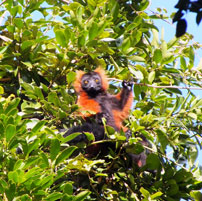 I was actually a bit anxious before I went to Madagascar; I had wanted to visit this island for so long that I was a bit nervous that it would not live up to my somewhat inflated expectations!
I was actually a bit anxious before I went to Madagascar; I had wanted to visit this island for so long that I was a bit nervous that it would not live up to my somewhat inflated expectations!
I am pleased to report that expectations were met and exceeded!
Madagascar is a bit of a cultural melting pot; is it part of Africa or is it an Indian Ocean Island? The answer is a bit of both, both economically and culturally, and the range of mountains which runs north to south along the spine of the country seems to be the unofficial dividing line with a more African influence discernible in the west of the island.
In addition however there remain long lasting influences from 5th century Indonesian settlers and of course from more recent French colonisers. Antananarivo, the capital, is a curious blend of the chaotic vibrancy of an African city merged with a splash of European sophistication; boulangeries and patisseries are found on most streets and the hundreds of city taxis all seem to be battered old Renaults!
Anyone who has read Rob’s trip report from his stay here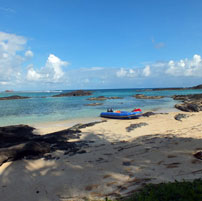 in April 2012 will know about the rich diversity of wildlife in Madagascar much of which is endemic to these shores; 260 species of birds, 117 of which are only found here, 108 species of lemur and 26 species of chameleon, but these numbers keep evolving with further recent discoveries. It really is a ‘must do’ on any wildlife enthusiasts list.
in April 2012 will know about the rich diversity of wildlife in Madagascar much of which is endemic to these shores; 260 species of birds, 117 of which are only found here, 108 species of lemur and 26 species of chameleon, but these numbers keep evolving with further recent discoveries. It really is a ‘must do’ on any wildlife enthusiasts list.
As Rob alluded to however, it has never been viewed as a totally purist wildlife destination; some of the national parks are close to busy local villages, noise from which can be heard whilst trekking, and some of the parks are ‘managed’ in order to give guests the best possible photographic opportunities. Moreover, accommodation is generally in hotels rather than small hosted camps which are so prevalent throughout Africa.
There is however an area which comes close to offering a ‘wilder’ experience and which should certainly be included on any itinerary if you are looking for some adventure and a destination showcasing an incredible diversity of habitat.
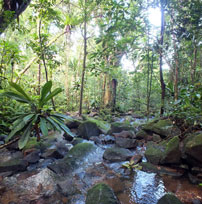 Masoala National Park is located on a peninsula in the north east of the island and access is either by a six day walk (three if you are Malagasy!) or an exhilarating boat ride across the Bay d’Angolin which will take a minimum of an hour and a half on a calm and sunny day, but can take up to three hours if the waters are a bit lumpy!
Masoala National Park is located on a peninsula in the north east of the island and access is either by a six day walk (three if you are Malagasy!) or an exhilarating boat ride across the Bay d’Angolin which will take a minimum of an hour and a half on a calm and sunny day, but can take up to three hours if the waters are a bit lumpy!
The Masoala Peninsula covers over 240,000 hectares and a large proportion of this is primary rain forest, where you will slip, slide and slither (it is a rainforest after all and it does rain for ten months of the year!) whilst trekking to see the famed red ruffed lemur, the white fronted brown lemurs and if you are lucky, the hard to find Aye Aye on a night walk – just three of the ten species of lemurs found here.
It is not all about the lemurs however as Masoala is a real hot spot 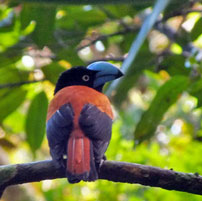 for birders who come here looking for the Helmut Vanga, the red breasted Coua and the Madagascar Red Owl amongst others. Chameleons too are in abundance and nocturnal walks are an excellent way to see these.
for birders who come here looking for the Helmut Vanga, the red breasted Coua and the Madagascar Red Owl amongst others. Chameleons too are in abundance and nocturnal walks are an excellent way to see these.
Away from the primary rainforest, Masoala has a great stretch of coastal forest with hiking trails through the mangroves and crystal clear rivers to be explored by pirogue or even to swim in.
Nor is the ocean, three sections of which are dedicated marine parks, without its attractions and from July through to September the sheltered waters of the Baie d’Angolin are home to the giant humpback whales which arrive from the Antarctic to calve and mate before their long journey south again. The best sightings are generally from a boat but I had an unintentional close encounter with these giants of the oceans when a gentle late afternoon paddle on a sea kayak turned into something far more memorable!
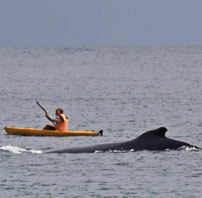 As we were preparing to depart, the tell-tale blow of a whale was seen not too far away so Pierre, the owner of Masoala Forest Lodge, cut our briefing short and instructions were given to paddle hard in an attempt to intercept the whales. Several minutes later we were rewarded as we floated gently on the water and no more than twenty metres away, bathed in the warmth of the setting sun, two sleek humpback whales broke the surface of the water and glided past us. That is a memory that will stay with me for a long time to come!
As we were preparing to depart, the tell-tale blow of a whale was seen not too far away so Pierre, the owner of Masoala Forest Lodge, cut our briefing short and instructions were given to paddle hard in an attempt to intercept the whales. Several minutes later we were rewarded as we floated gently on the water and no more than twenty metres away, bathed in the warmth of the setting sun, two sleek humpback whales broke the surface of the water and glided past us. That is a memory that will stay with me for a long time to come!
Masoala is an adventurous destination and the wildlife is not as easily seen as elsewhere, but for richness of biodiversity it is hard to beat. There aren’t many places where you can trek in a rainforest in the morning and snorkel in crystal clear waters in the afternoon.
If you have been on safari elsewhere in Africa you definitely need to change your mind set before arriving in Madagascar. It does not feel as remote as other areas in Africa but it does offer spectacular landscapes, wildlife you won’t see anywhere else and the friendliest people!
What it does not have however is a good internal flight network, so along with your change of mind set, you will also need to take along a lot of patience and a sense of humour! Flight schedules seem to change at the drop of a hat and you may end up exploring an area that you weren’t expecting to visit, but thanks to our very efficient partners on the ground in Madagascar, changes will be made as smooth as possible and you can simply enjoy your continuing adventure!
